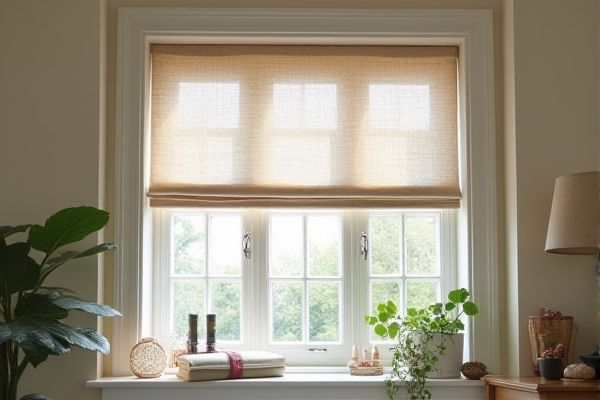
Roman blinds offer a soft, elegant look with fabric that folds neatly, providing a smooth, tailored appearance and excellent light control, while Venetian blinds consist of horizontal slats that can be tilted for precise light adjustment and enhanced privacy. Explore the rest of the article to discover which style best complements your space and meets your functional needs.
Table of Comparison
| Feature | Roman Blind | Venetian Blind |
|---|---|---|
| Design | Fabric panels fold into horizontal pleats | Horizontal slats made of wood, aluminum, or PVC |
| Light Control | Limited; blocks light when lowered | Adjustable slats allow precise light regulation |
| Privacy | Full privacy when closed | Adjustable for partial privacy |
| Installation | Mounted inside or outside window frame | Mounted inside or outside window frame |
| Maintenance | Requires fabric cleaning | Easy to clean with a cloth or duster |
| Best Use | Living rooms, bedrooms for style and warmth | Kitchens, offices for light control and ventilation |
| Cost | Moderate to high | Low to moderate |
Introduction to Window Blinds: Roman vs Venetian
Roman blinds offer a sleek, fabric-based design that folds neatly when raised, providing a soft, elegant look ideal for enhancing interior decor. Venetian blinds feature horizontal slats made of wood, metal, or plastic, allowing precise control over light and privacy through adjustable tilt angles. Choosing between these blinds depends on your preference for style, light control, and maintenance, with Roman blinds emphasizing aesthetics and Venetian blinds prioritizing functionality.
Design and Aesthetics: Roman Blind vs Venetian Blind
Roman blinds offer a soft, elegant look with smooth fabric folds that create a tailored, sophisticated appearance, ideal for adding warmth and texture to your space. Venetian blinds feature horizontal slats made from wood, metal, or plastic, providing a sleek, modern aesthetic with adjustable light control and a more structured feel. Your choice between Roman and Venetian blinds will influence the overall ambiance and style of your room, balancing softness versus crisp lines.
Material Comparison: Fabric or Slats?
Roman blinds feature soft fabric panels that fold neatly when raised, offering a smooth, elegant appearance and excellent light diffusion ideal for living rooms and bedrooms. Venetian blinds consist of horizontal slats made from aluminum, wood, or PVC, providing precise light control and durability suited for kitchens and offices. Fabric materials in Roman blinds allow for extensive customization in texture and patterns, whereas Venetian blind slats vary in thickness and finish to balance privacy, light filtration, and maintenance.
Light Control and Privacy Differences
Roman blinds offer soft fabric folds that provide diffused light and moderate privacy by filtering sunlight gently. Venetian blinds consist of horizontal slats that can be precisely tilted, allowing you to control light intensity and maintain adjustable levels of privacy effectively. Your choice depends on whether you prioritize a softer ambiance with partial privacy or versatile, customizable light and privacy control.
Installation Process: Which Is Easier?
Roman blinds feature a straightforward installation process involving mounting brackets and a headrail, making them easier for DIY projects. Venetian blinds require fitting horizontal slats and a more complex mechanism for tilt and raise functions, often demanding precise alignment. Overall, Roman blinds typically offer simpler installation with fewer components, reducing setup time and effort.
Maintenance and Cleaning Requirements
Roman blinds require gentle maintenance, typically involving spot cleaning or dry cleaning to preserve their fabric folds and prevent damage. Venetian blinds, usually made of aluminum, wood, or PVC, are easier to clean with regular dusting or wiping using a damp cloth, making them more practical for spaces prone to dust accumulation. Both types benefit from routine inspection to ensure smooth operation and longevity, but Venetian blinds generally demand less intensive upkeep.
Durability and Longevity
Roman blinds, crafted from fabric layers, offer moderate durability but may show wear over time due to folding mechanisms and fabric exposure to sunlight. Venetian blinds, typically made from aluminum, wood, or PVC, provide superior longevity and resistance to moisture, making them ideal for high-traffic or humid areas. The choice between Roman and Venetian blinds often depends on the balance between aesthetic preference and the need for long-lasting, low-maintenance window treatments.
Cost Comparison: Roman vs Venetian Blinds
Roman blinds generally have a higher upfront cost compared to Venetian blinds due to their fabric construction and complex mechanisms. Venetian blinds, often made from aluminum or wood, tend to be more affordable and offer easier maintenance, making them cost-effective for budget-conscious buyers. Installation and long-term durability also influence overall value, with Venetian blinds typically requiring less frequent replacement.
Best Uses and Room Suitability
Roman blinds offer a soft, elegant look ideal for living rooms and bedrooms where you want to create a warm, cozy atmosphere with controlled light filtering. Venetian blinds provide precise light control and durability, making them well-suited for kitchens, bathrooms, and offices where moisture resistance and adjustability are important. Selecting between these blinds depends on your room's function and design, with Roman blinds excelling in comfort and aesthetic while Venetian blinds prioritize versatility and easy maintenance.
Choosing the Right Blind for Your Space
Roman blinds offer a soft, elegant look with fabric panels that fold neatly when raised, making them ideal for living rooms or bedrooms where a warm ambiance is desired. Venetian blinds, featuring horizontal slats made from wood, aluminum, or PVC, provide precise light control and suit modern offices or kitchens requiring adjustable privacy and durability. Selecting between these blinds depends on your space's style, light needs, and maintenance preferences.
 homyna.com
homyna.com